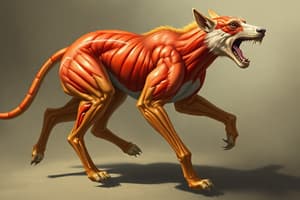Podcast
Questions and Answers
Flashcards
Locomotion
Locomotion
The movement of an organism from one place to another.
Protoplasmic Streaming
Protoplasmic Streaming
The movement of the cytoplasm within a cell, often seen in Amoeba.
Cilia
Cilia
Hair-like projections on the surface of cells that beat rhythmically to move fluids or propel the cell.
Flagella
Flagella
Signup and view all the flashcards
Muscle Tissue
Muscle Tissue
Signup and view all the flashcards
Contractility
Contractility
Signup and view all the flashcards
Extensibility
Extensibility
Signup and view all the flashcards
Elasticity
Elasticity
Signup and view all the flashcards
Skeletal Muscles
Skeletal Muscles
Signup and view all the flashcards
Visceral Muscles
Visceral Muscles
Signup and view all the flashcards
Cardiac Muscle
Cardiac Muscle
Signup and view all the flashcards
Sarcolemma
Sarcolemma
Signup and view all the flashcards
Sarcoplasm
Sarcoplasm
Signup and view all the flashcards
Sarcoplasmic Reticulum
Sarcoplasmic Reticulum
Signup and view all the flashcards
Myofibrils
Myofibrils
Signup and view all the flashcards
Sarcomere
Sarcomere
Signup and view all the flashcards
Actin
Actin
Signup and view all the flashcards
Myosin
Myosin
Signup and view all the flashcards
I Band
I Band
Signup and view all the flashcards
A Band
A Band
Signup and view all the flashcards
Troponin
Troponin
Signup and view all the flashcards
Tropomyosin
Tropomyosin
Signup and view all the flashcards
Neuromuscular Junction
Neuromuscular Junction
Signup and view all the flashcards
Acetylcholine
Acetylcholine
Signup and view all the flashcards
Sliding Filament Theory
Sliding Filament Theory
Signup and view all the flashcards
Motor Unit
Motor Unit
Signup and view all the flashcards
Muscle Fatigue
Muscle Fatigue
Signup and view all the flashcards
Myoglobin
Myoglobin
Signup and view all the flashcards
Red Muscle Fibers
Red Muscle Fibers
Signup and view all the flashcards
White Muscle Fibers
White Muscle Fibers
Signup and view all the flashcards
Skeletal System
Skeletal System
Signup and view all the flashcards
Axial Skeleton
Axial Skeleton
Signup and view all the flashcards
Appendicular Skeleton
Appendicular Skeleton
Signup and view all the flashcards
Study Notes
Locomotion and Movement
- Movement is a key feature of all living things, ranging from protoplasm streaming in single-celled organisms to complex animal movements.
- Locomotion is a specific type of movement involving a change in location. Human movements include walking, running, climbing, and swimming.
- Various types of movements exist, such as amoeboid, ciliary, and muscular, suited to different organisms and environments.
- Movement is crucial for finding food, shelter, mates, suitable habitats or escaping predators.
- Skeletal, muscular, and neural systems work together to facilitate locomotion.
Types of Movement
- Amoeboid movement: Characterized by pseudopodia formation, seen in some specialized cells such as macrophages and leucocytes, and involves the streaming of protoplasm.
- Ciliary movement: Coordinated movement of cilia, which are hair-like structures, aids in moving substances and fluids. This is common in many internal tubular organs.
- Muscular movement: Contractile property of muscles is critical for human movement and enables changes in body posture
Muscles
- Skeletal muscles: Striated, voluntary muscles attached to the skeletal components, crucial for locomotion and body posture.
- Visceral muscles (Smooth muscles): Non-striated, involuntary muscles in internal organs, aiding various bodily functions like digestion or reproduction.
- Cardiac muscles: Striated, involuntary muscles in the heart, responsible for heart contractions, essential for blood circulation.
Skeletal System
- Framework of bones and cartilages supporting the body; critical for movement.
- Axial skeleton: 80 bones forming the central axis of the body. Includes skull, vertebral column, ribs, and sternum.
- Appendicular skeleton: Bones of limbs and girdles, allowing for complex movements involving limbs and body appendages.
- Joints: Points where bones meet, enabling flexible movement; are classified into fibrous, cartilaginous, and synovial types based on the type of material connecting them. Synovial joints facilitate the most extensive movement.
- Bones are complex organs, containing different materials and cells.
- Bone formation and growth are continuous processes.
Structure of Contractile Proteins
- Actin filaments ('thin filaments'): Made of intertwined, monomeric actin proteins. Tropomyosin and troponin are regulatory proteins associated with actin.
- Myosin filaments ('thick filaments'): Composed of many myosin molecules. Myosin heads possess ATPase enzyme activity and binding sites for actin.
Mechanism of Muscle Contraction
- Sliding filament theory: Muscle contraction results from the sliding of actin filaments along myosin filaments.
- Interactions between actin and myosin within the sarcomere (muscle segment) cause the muscle fibres to shorten.
- The energy required for this process comes from ATP hydrolysis.
Disorders of Muscular and Skeletal Systems
- Muscular dystrophy: Genetic disorder that results in progressive degeneration of muscles.
- Arthritis: Inflammation of joints.
- Osteoporosis: Decreased bone mass due to decreased estrogen levels.
Summary
- Movement is a vital function for all organisms.
- Types of movements—amoeboid, ciliary, muscular.
- Muscles (skeletal, visceral, and cardiac) are fundamental for movement and activity.
- Skeletal structure (axial and appendicular skeletons) supports, protects, and enables movement.
- Joints allow for flexibility needed in movement.
- Multiple systems work together for efficient body movements.
Studying That Suits You
Use AI to generate personalized quizzes and flashcards to suit your learning preferences.





